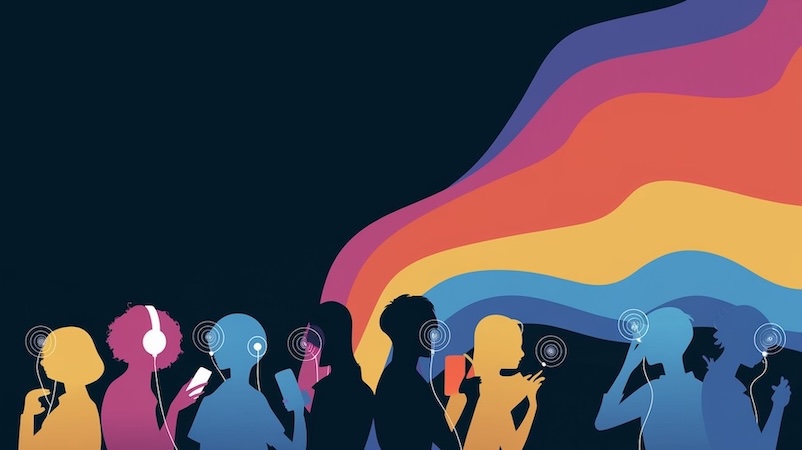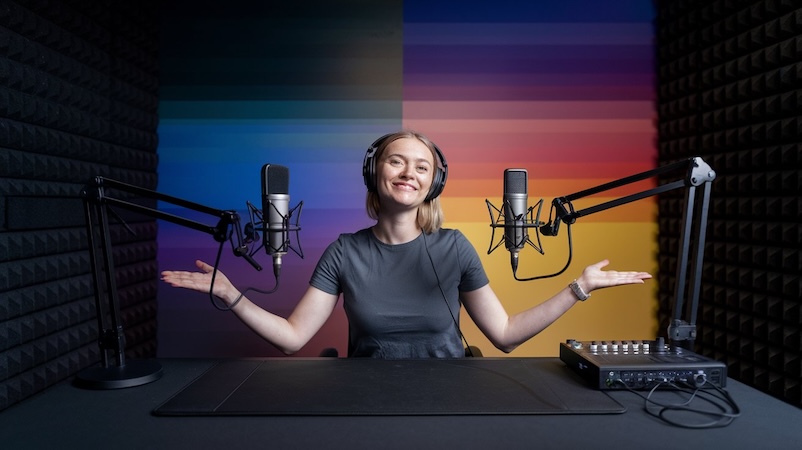How to Start a Podcast in 2025: The Ultimate Step‑by‑Step Guide
Why 2025 is the perfect year to start

Podcast listening keeps climbing across every demographic, and advertisers now spend over €4 billion in Europe alone. More importantly, AI tooling has flattened the technical learning curve, so your focus can stay on ideas and community. Podigee's brand‑new MCP Server even lets you query your listener data in plain language.
Step 1 – Plan your podcast
1.1 Define your "why"
Jot down a single‑sentence mission. Example: "Help freelance designers master pricing." This north‑star will guide topic selection and keep you motivated when downloads plateau.
1.2 Find your niche
- Audit Apple Podcasts & Spotify to spot gaps.
- Use Google's "People also ask" to collect real‑world questions.
- Draft ten episode titles – if you struggle after five, narrow the topic.
1.3 Define your ideal listener
Create a quick persona: age, job, favorite social channel, pain point. Tailor episodes and calls‑to‑action to this single archetype.
Step 2 – Craft a magnetic brand
2.1 Choose a searchable name
Keep it to four words or fewer and include a keyword listeners will actually type, e.g. "Design Pricing Podcast."
2.2 Design scroll‑stopping cover art
- 3000 × 3000 px JPEG or PNG.
- High‑contrast colors that still pop at 55 × 55 px.
- No tiny text and no generic mic graphics.
2.3 Write a conversion‑optimized description
In the first 120 characters summarise your unique promise, then sprinkle 1‑2 long‑tail keywords naturally.
Step 3 – Pick a format & structure
Choose the format that matches both your energy and your calendar:
| Format | Best for | Editing effort |
|---|---|---|
| Solo narrative | Storytelling, short tips | Low |
| Co‑hosted | Conversation & banter | Medium |
| Interview | Expert insights | Medium |
| Scripted fiction | Audio drama fans | High |
Episode length? Match your audience's routine: 8‑12 min for commuters, 30‑45 min for deep‑dives, or 60 + for true crime marathons.
Step 4 – Choose equipment without overspending

4.1 Essentials
- Mic – Samson Q2U (USB/XLR) or Rode PodMic for EU availability.
- Headphones – Closed‑back (Audio‑Technica M20x) to avoid bleed.
- Pop filter & boom arm – €15 each, saves hours of de‑essing.
4.2 Optional extras
If video is part of your strategy, a mirrorless camera (Sony ZV‑E10) plus a ring light will lift watch‑time on YouTube Shorts.
Step 5 – Select recording & editing software
- All‑in‑one – Riverside or Descript for local 4K plus transcript editing.
- Classic DAW – Audacity (free) or Adobe Audition for full control.
- Mobile – Podigee App (iOS/Android) to push field recordings straight into your media library.
Step 6 – Record like a pro
6.1 Prep the room
Soft furnishings beat foam panels. Shut windows, kill fridge hum, place a rug under your chair.
6.2 Capture clean audio
- Set mic gain so peak levels hit −12 dB.
- Record a 30‑sec test and listen back on headphones.
- Save separate tracks for each participant.
6.3 Remote interviews that don't sound remote
Use local‑track platforms and instruct guests to wear wired earbuds. Mail them a Q2U if audio quality matters more than the €70.
Step 7 – Edit fast with AI
Good editing removes distractions without killing personality. Workflow:
- Run an AI cleaner (e.g. Auphonic) to level loudness, reduce noise and balance voices.
- Edit by text to cut tangents in minutes.
- Add a 3‑second branded sting at open and close.
- Export WAV (archive) and MP3 (distribution, 128 kbps joint stereo).
Step 8 – Publish & host with Podigee
Hosting is the engine room of discoverability. Podigee gives you:
- Unlimited storage & traffic – no surprise overage bills.
- One‑click distribution to Apple, Spotify, Amazon and YouTube.
- MCP Server – ask natural language questions about your data: "Which episode converted most newsletter sign‑ups last month?"
- Privacy‑focused analytics – secure, anonymized listener data with robust access controls.
- Dynamic Ad Marketplace to plug in host‑read or programmatic campaigns.
After uploading, double‑check the auto‑generated show notes and schedule your release for your audience's prime slot (use Podigee analytics to confirm).
Step 9 – Optimize for Google & LLM search
9.1 Traditional SEO
- Include your focus keyword "how to start a podcast" in title, H1, first 100 words, meta description and alt tags.
- Embed a full transcript for accessibility and keyword depth.
- Secure backlinks by guesting on related shows and linking back.
9.2 LLM‑aware optimization
- Write concise, fact‑rich answers – language models favor passages that can stand alone.
- Mark up FAQ with
FAQPageschema (example below). - Use structured timestamps – Gemini and ChatGPT surface "key moments" in audio.
Step 10 – Promote & monetize
10.1 Promotion playbook
- Repurpose each episode into a newsletter, LinkedIn carousel and three Shorts.
- Cross‑promo: swap 30‑second trailers with shows of similar size.
- Answer Reddit or Quora threads with value first, link second.
10.2 Monetization options
- Dynamic ads via Podigee Marketplace.
- Paid memberships – private RSS for bonus content.
- Affiliate links – disclose and pick niche‑relevant products.
Launch‑day checklist
- ☑ Mission statement written
- ☑ 3 episodes recorded, edited and scheduled
- ☑ Cover art meets 3000 px spec
- ☑ Show description under 600 characters
- ☑ Trailer teaser uploaded
- ☑ RSS feed (use Podigee to save time and headaches)
- ☑ Apple, Spotify, Amazon and YouTube submitted
- ☑ Welcome email sequence ready
- ☑ Social media graphics queued
- ☑ Celebrate – then start writing episode 4
FAQ
How do I start a podcast?
Define your concept and audience, pick a format, record a trailer and a few episodes with an entry‑level mic, upload them to a host like Podigee, and submit your RSS feed to platforms such as Apple Podcasts and Spotify.
How much does it cost to start a podcast?
Between €70 (Q2U mic plus free software) and whatever your camera habit allows. Hosting on Podigee starts with a free trial, then scales with your needs.
Do I need a license for music?
Use royalty‑free libraries or obtain a sync license. Better yet, commission a short custom jingle.
What is the ideal episode length?
The sweet spot in 2025 is 20‑40 minutes – long enough for depth, short enough for busy feeds.
How do I choose the right microphone for my podcast?
Consider factors such as budget, frequency response, and the type of content you're producing. Samson Q2U or Rode PodMic are popular choices for quality audio.
What is the best way to record remote interviews?
Use local‑track platforms like Zoom or Discord to connect with guests. Ensure good audio quality by using wired earbuds and a pop filter.
How can I promote my podcast effectively?
Leverage multiple channels such as social media, email newsletters, and guest appearances on other podcasts. Cross‑promote with similar shows and repurpose content for different platforms.
Ready to Launch Your Podcast?
Start creating today with the platform trusted by professional podcasters worldwide:
14-Day Free Trial
Test all premium features with absolutely no limitations
No Credit Card Required
Zero risk, zero unexpected charges after your trial
100% Content Ownership
Your podcast remains yours - always and forever
One-Click Distribution
Publish everywhere that matters with a single click
Join over 10,000 podcasters who trust Podigee to power their audio content
